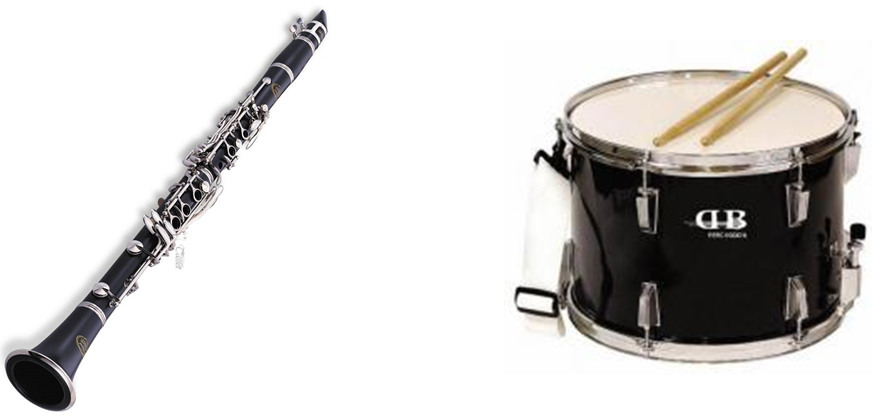Here are two instruments. How does each one make sound? Which one is more similar to the way humans make language sounds, and why?

As you've seen from the previous activity, there are lots of subtle differences between pronunciations, and these can't always be explained with traditional casual ways of explanation. We need a very systematic and formal way to describe how every sound is made. That's what phonetics is for.
Read the chapter below to learn how to describe sounds phonetically. Once you've finished, proceed to the activities to practice.
Reading: Chapter 2, "Phonetics", sections 2.1-2.3 (pp. 28-41) of McGregor, W., Linguistics: An Introduction, Continuum, 2009. (This could be replaced with a phonetics chapter from pretty much any introductory linguistics textbook, as long as it describes the common features of consonants. A good free alternative is Essentials of Linguistics chapter 2, "Producing speech sounds."; the most important sections for this module are 2.1 "How humans produce speech", 2.2 "Articulators", and 2.6 "Classifying consonants".)
Here are two instruments. How does each one make sound? Which one is more similar to the way humans make language sounds, and why?

Just like the clarinet (單簧管) in the previous question, the human speech system is a tube (review the pictures from the reading). When people play a clarinet or similar instrument, they can make different sounds by closing the tube in different places or different ways. Human speech works the same way: we make sound by blowing air through our tube (from the lungs, up the throat, and out the mouth and/or nose), and we change sounds by changing the way the air flows and/or closing the tube in different places or in different ways.
To slightly simplify from the reading, there are three basic ways we can change a sound, and they correspond to three basic phonetic "features". (The way I am categorizing features here may be different than what's presented in some readings; there are lots of different theories about how to organize phonetic features.) They are as follows:
Below, I will give three examples of different syllables. For each example, state which feature is different between two Cantonese syllables, or which feature is different between the two Mandarin syllables, or which feature is different between the two English syllables (you only need to look at one language; I am just providing different options for students who aren't proficient in one or more of these languages). Answers are provided at the end of this page.
Example 1
Cantonese: 他 vs. 沙
Mandarin: 他 vs. 撒谎的撒
English: ton vs. sun
The difference between the two sounds is _____.
Example 2
Cantonese: 爆炸的爆 vs. 教堂的教
Mandarin: 爆炸的爆 vs. 告诉的告
English: bot vs. got
The difference between the two sounds is ____.
Example 3
Cantonese: 家 vs. 卡
Mandarin: 差劲的差 vs. 爆炸的炸
English: cheese vs. jeez
The difference between the two sounds is ____.
Thinking back to the previous section of the module, I demonstrated two different pronunciations of 人 in Mandarin. How could you describe these different pronunciations phonetically? (You can listen to the recording again below.)
Phonetically describe the initial consonant of each of these syllables (mention whether you are using Mandarin or Cantonese or some other Chinese language). You don't actually need to know Chinese to do this exercise; if you don't know any Chinese language, you could ask a friend who knows Chinese to pronounce them, or you could listen to a recording in an online dictionary. As long as you understand the phonetic features you should be able to figure out what these sounds are, even if you don't know the language.
For each description, think of a syllable/character whose initial consonant has that pronunciation (mention whether you are using Mandarin or Cantonese). It's possible that some of these sounds might not occur in Mandarin or might not occur in Cantonese; if so, you can just say this sound does not occur. If you aren't proficient in both Mandarin and Cantonese, you might need to search online, or find a friend who speaks those languages and make that sound for them and ask them for a word that has the sound. (The purpose of this exercise is not to test your vocabulary knowledge, but to test how well you can understand these phonetic descriptions. Thus, you can succeed on this exercise even if you don't speak Chinese. As long as you know how to make, e.g., a bilabial nasal sound, you can make that sound to a Chinese speaker and ask them to give you an example word that starts with that sound.)
When you have finished these activities, continue to the next section of the module: "Making sounds: the Pink Trombone".
Answers for practice activity comparing different syllables: example 1 is manner, example 2 is place, example 3 is aspiration (it's also ok if you said voicing).
Answer for phonetic descriptions of 人: the first three examples in the recording are pronounced with a fricative, and the last three are pronounced with an approximant.
Answers for describing the initial consonants of four Chinese syllables (here I'm assuming Mandarin pronunciation): 平 starts with an aspirated bilabial stop, 開 starts with an aspirated velar stop (in Cantonese it starts with a voiceless glottal fricative instead); 梁 starts with an alveolar lateral approximant, and 吵 starts with an aspirated retroflex affricate (in Cantonese and in some varieties of Mandarin this will be alveolar instead of retroflex)
Answers for thinking of words: There are many possible answers. Bilabial nasal could be 門 in Mandarin or Cantonese; unaspirated alveolar stop could be 大 in Mandarin or Cantonese; velar nasal does not occur syllable-initially in Mandarin but could be 我 in Cantonese; unaspirated alveolar affricate does not occur syllable-initially in Cantonese but could be 组 in Mandarin.
by Stephen Politzer-Ahles. Last modified on 2021-04-18. CC-BY-4.0.